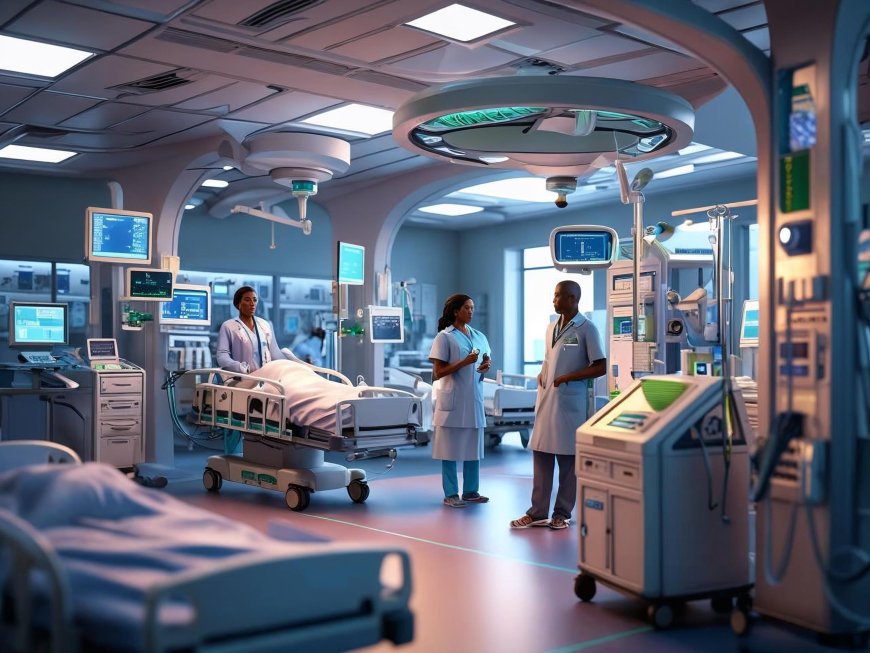The Role of IoMT (Internet of Medical Things) in African Hospitals
This white paper explores how the Internet of Medical Things (IoMT) can transform African hospitals through real-time monitoring, operational efficiency, and patient-centered care—while addressing barriers like infrastructure, interoperability, and cybersecurity.

Abstract
The Internet of Medical Things (IoMT)—a network of interconnected medical devices that collect and share health data—has the potential to revolutionize hospital care across Africa. From remote monitoring and smart diagnostics to inventory automation, IoMT solutions can drastically improve patient safety, efficiency, and outcomes. This white paper outlines IoMT applications in African hospitals, benefits, challenges (including connectivity, standards, and security), and recommendations for successful deployment.
Introduction
Africa’s hospital systems face systemic challenges—understaffing, resource mismanagement, and overcrowding (World Health Organization [WHO], 2023). While digital health solutions have expanded, many hospitals still operate without integrated data systems. IoMT offers a powerful framework: by connecting medical equipment, patient monitors, and diagnostics to a unified network, hospitals can access real-time insights to improve decision-making and reduce errors (Deloitte, 2021).
What Is IoMT?
The Internet of Medical Things includes wearable sensors, infusion pumps, diagnostic machines, mobile monitors, and hospital IT systems that communicate via cloud or edge networks (Ahuja & Thatcher, 2022).
Common devices:
-
Vital sign monitors
-
Connected insulin pumps
-
Smart beds and wheelchairs
-
RFID-based inventory systems
-
Wearable ECG or glucose monitors
These devices collect patient or operational data and transmit it to clinicians or dashboards in real time.
Applications in African Hospitals
1. Remote Patient Monitoring
-
Continuously track vitals (e.g., heart rate, oxygen levels) for inpatients.
-
Reduce nurse workload and improve early detection of deterioration.
-
Particularly valuable in ICU and COVID-19 wards.
Example: In Kenya, Jacaranda Health piloted mobile vitals monitors for maternity care.
Source
2. Asset Tracking & Inventory Management
-
RFID-enabled inventory ensures availability of drugs, oxygen, and surgical supplies.
-
Reduces theft, wastage, and downtime due to missing equipment.
3. Smart Diagnostic Devices
-
IoMT-enabled ultrasound or blood analyzers can transmit results to EMRs or cloud platforms for real-time decision support.
4. Infection Control
-
Smart dispensers and wearable badges monitor hand hygiene compliance.
-
Environmental sensors detect airborne pathogens or temperature anomalies.
5. Post-Discharge Monitoring
-
Wearable devices allow remote follow-up care for cardiac, diabetic, or hypertensive patients in rural areas.
Benefits of IoMT in African Context
| Benefit | Description |
|---|---|
| Efficiency Gains | Automation reduces nurse burnout and administrative workload |
| Improved Outcomes | Real-time vitals improve responsiveness in emergencies |
| Data Integration | Enhanced interoperability with national EMRs (where available) |
| Operational Savings | Prevents medication errors and inventory shrinkage |
| Decentralized Care | Enables rural-urban health system extension via wearables and mobile tools |
Insight: IoMT could reduce hospital readmissions by 20–30% through better post-discharge monitoring (McKinsey, 2020).
Source
Challenges to IoMT Adoption in Africa
1. Connectivity & Infrastructure
-
Many hospitals still lack reliable electricity and internet.
-
IoMT requires broadband, edge computing, or hybrid networks to function effectively.
2. Data Standards & Interoperability
-
Devices must follow global health IT standards like HL7, FHIR, or DICOM to integrate into national systems (GSMA, 2023).
3. Cybersecurity & Patient Privacy
-
Interconnected systems increase risk of ransomware or patient data leaks.
-
Need for Africa-specific data protection frameworks (UNECA, 2022).
4. Device Affordability & Maintenance
-
High upfront costs and lack of local servicing partners make long-term usage difficult for public hospitals.
5. Workforce Readiness
-
Staff training is needed to effectively use, interpret, and troubleshoot IoMT devices.
Strategic Recommendations
-
Public-Private Pilots
Launch testbeds with ministries of health, startups, and telecoms to demonstrate ROI in tertiary hospitals. -
Hybrid Connectivity Models
Use offline-first or edge-based IoMT systems that sync when connected, especially in rural facilities. -
Strengthen Health IT Standards
Enforce interoperability and procurement standards to prevent vendor lock-in. -
Build Local Supply Chains
Encourage African manufacturing or repair hubs for medical IoT devices to reduce downtime. -
Digital Health Policies
Expand digital health laws to include medical IoT governance, consent, and cybersecurity compliance.
Conclusion
IoMT has transformative potential to modernize hospital care in Africa—from real-time monitoring to smarter diagnostics. With strategic investment in connectivity, standards, and workforce readiness, African health systems can build next-generation, connected hospitals that are more efficient, safer, and responsive to patient needs.
References (APA 7th Edition)
Ahuja, A. S., & Thatcher, R. (2022). The role of the Internet of Medical Things (IoMT) in smart hospitals: A review. Healthcare Technology Letters, 9(1), 1–7. https://doi.org/10.1049/htl2.12034
Deloitte. (2021). IoMT: The future of connected healthcare.
https://www2.deloitte.com/content/dam/Deloitte/global/Documents/Life-Sciences-Health-Care/deloitte-gx-lshc-iomt.pdf
GSMA. (2023). The Mobile Economy Sub-Saharan Africa 2023.
https://www.gsma.com/mobileeconomy/sub-saharan-africa/
Jacaranda Health. (2022). Innovating maternal health in Kenya.
https://www.jacarandahealth.org/
McKinsey & Company. (2020). The Internet of Things: Mapping the value beyond the hype.
https://www.mckinsey.com/business-functions/mckinsey-digital/our-insights/the-internet-of-things-in-healthcare
UNECA. (2022). Africa digital health regulatory frameworks report.
https://repository.uneca.org/handle/10855/46742
World Health Organization. (2023). Global health observatory data.
https://www.who.int/data/gho
What's Your Reaction?
 Like
0
Like
0
 Dislike
0
Dislike
0
 Love
0
Love
0
 Funny
0
Funny
0
 Angry
0
Angry
0
 Sad
0
Sad
0
 Wow
0
Wow
0



















































